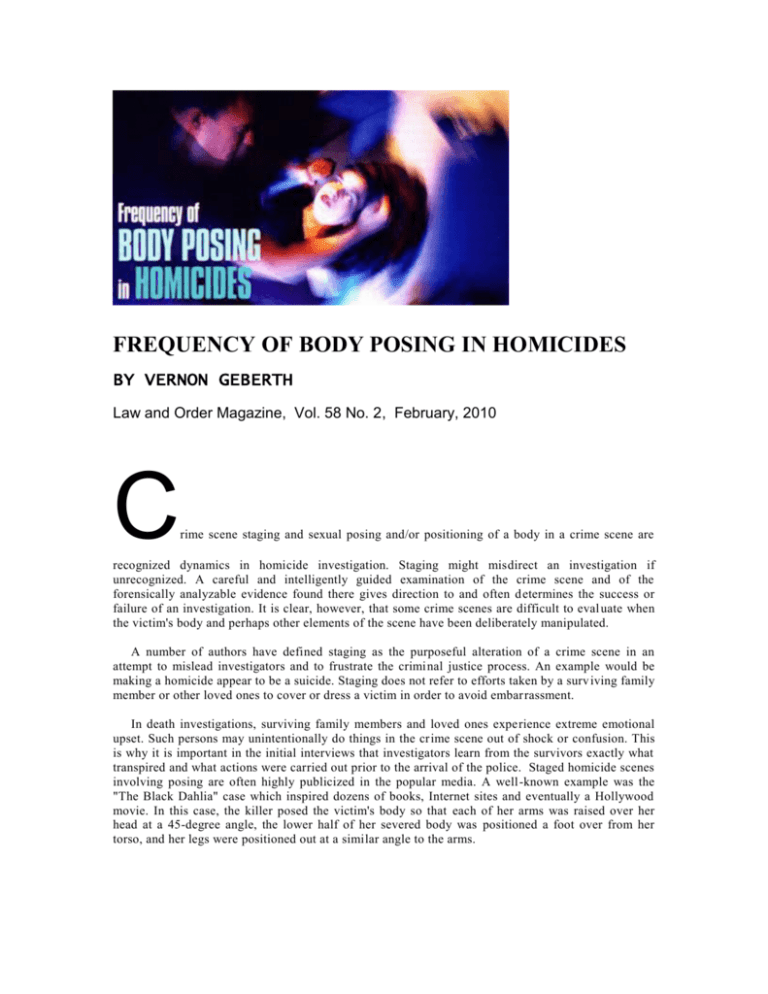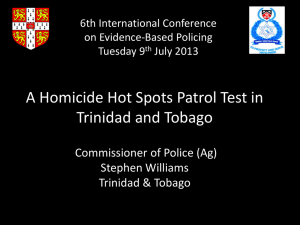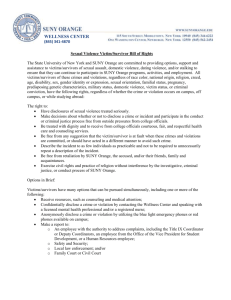
FREQUENCY OF BODY POSING IN HOMICIDES
BY VERNON GEBERTH
Law and Order Magazine, Vol. 58 No. 2, February, 2010
C
rime scene staging and sexual posing and/or positioning of a body in a crime scene are
recognized dynamics in homicide investigation. Staging might misdirect an investigation if
unrecognized. A careful and intelligently guided examination of the crime scene and of the
forensically analyzable evidence found there gives direction to and often d etermines the success or
failure of an investigation. It is clear, however, that some crime scenes are difficult to eval uate when
the victim's body and perhaps other elements of the scene have been deliberately manipulated.
A number of authors have defined staging as the purposeful alteration of a crime scene in an
attempt to mislead investigators and to frustrate the criminal justice process. An example would be
making a homicide appear to be a suicide. Staging does not refer to efforts taken by a surv iving family
member or other loved ones to cover or dress a victim in order to avoid embar rassment.
In death investigations, surviving family members and loved ones experience extreme emotional
upset. Such persons may unintentionally do things in the crime scene out of shock or confusion. This
is why it is important in the initial interviews that investigators learn from the survivors exactly what
transpired and what actions were carried out prior to the arrival of the police. Staged homicide scenes
involving posing are often highly publicized in the popular media. A well-known example was the
"The Black Dahlia" case which inspired dozens of books, Internet sites and eventually a Hollywood
movie. In this case, the killer posed the victim's body so that each of her arms was raised over her
head at a 45-degree angle, the lower half of her severed body was positioned a foot over from her
torso, and her legs were positioned out at a similar angle to the arms.
Such staged crime scenes, if not recognized for what they are, might be difficult to solve. It is
obviously important that those who investigate homicides be aware of the characteristics of staging
and the motivations of those who engage in such activity.
Review of Relevant Literature
Little is known about the frequency of staged homicides or the motivation of offenders who stage
such crimes. Offenders who are successful in evading detection by staging a crime scene might find
greater encouragement for continued offending. Of course, those who sta ge a scene for purposes other
than avoiding detection, such as for inner psychological needs, might inad vertently complicate or
frustrate an investigation even though their intention is not necessarily to do so.
The frequency and motivation seen in staged or other homicides are not statistics maintained in
justice system data. Those statistics need to be drawn from those who have access to such detailed
information about homicides-the investigators themselves.
According to Keppel and Weiss in an article they wrote in 2004, "The act of leaving a victim's
body in an unusual position is a conscious criminal action by an offender to thwart an investigation,
shock the finder and investigators, or give perverted pleasure to the killer." However, within that same
article they attempt to differentiate posing from staging: "Posing is not to be confused with staging
because staging refers to manipulation of the scene around the body as well as posi tioning of the body
to make the scene appear to be something it is not."
I consider sexual posing as a subset of staging. Any change in the crime scene which includes the
manipulation of a victim's body is in fact staging.
Regardless of the differences in how to define terms, sexual posing of a body in a crime scene is a
rarity. In a study by Hazelwood and Napier published in 2004, 20 investigators, both active and
retired, were surveyed about their knowledge of staged crimes. These investigators had an average of
28 years of law enforcement experience and collectively had either investigated or consulted on
33,630 violent crimes, averaging 1,682 each.
The study found that staging was seen in less than 3 percent of crimes 903 times out of 33,630 of
all crimes-and about 1 percent of those cases involved death. Their study did not examine homicides
exclusively but also focused on non-fatal and
alleged sexual assaults, and involved a survey of
It is important that those who
only 20 respondents. Moreover, the focus was
investigate homicides be aware of
on the broad notion of staging and did not
the characteristics of staging and
consider the specific form of staging in which
there is sexual posing of a body.
the motivations of those who
engage in such activity.
In addition to the limited information gathered
from the above literature, the author queried the
Center for Disease Control (CDC) Morbidity Studies, the Regional Organized Crime Information Center
(ROCK), the Violent Criminal Apprehension Program (VICAP), the Federal Bureau of Investigation
Behavioral Analysis Unit (BAU) and the National Center for the Analysis of Violent Crime (NCAVC) to
determine if there were any statistics available on the total number of staged homicides. Official
statistics on homicide staging were not available from these agencies. Similarly, there were no official
statistics regarding the sexual posing of a body at crime scenes.
The Purpose of This Study
This study was conducted to provide investigators with a frame of reference regarding staged
homicide scenes involving posing. There seems to be a general perception, even among law
enforcement officers, that staging, especially sexual posing in the killing of a woman, is quite
prevalent.
The author contacted 43 persons who are considered homicide experts. Each respondent had either
been in command of a homicide division or had served as a homicide investigator. All of the
respondents were nationally renowned homicide investigation consultants who regularly provided
expert testimony and advanced training in their particular field of expertise.
The respondents had a total of 1,114 cumulative years of experience in death investigation,
averaging 25 years per investigator. The respondents collectively estimated that they had investigated,
supervised or consulted on 44,541 homicide investigations, averaging 1,035 homicides per
investigator.
The respondents in this sample were selected so that the responses were representative of major
city, county and state law enforcement agencies throughout the United States. Prior to the data
collection, the respondents were contacted by phone and informed about the nature of the research.
Surveys were then distributed electronically via e-mail.
The survey contained a structured series of questions asking for descriptive information regarding
the respondent's name, agency affiliation and location, and years of investigative experience. Specific
open-ended questions relevant to the respondents' exposure to crime scene elements that were the
focus of this research were included.
The term "sexual posing" was defined as the deliberate act of sexually positioning the body in the
crime scene. This includes presenting a totally nude or partially clothed victim's body for display
which has been manipulated in a manner to expose the breasts, buttocks and/or genitalia. In addition
to these, the following could also be considered as deliberate sexual positioning: spreading open legs,
splaying out arms, presenting the victim in bondage and/or binding the hands behind the back, hanging
the nude or semi-nude body, insertion of foreign objects, engaging in sexual mutilation, cutting,
evisceration, and/or overkill injuries.
Determining Motivation
A detailed examination of motivation in sexually-posed homicides was possible in 76 of the cases
provided by the surveyed respondents and the 109 sexually posed cases in my own personal files. In each
of these 185 cases, full documentation, such as crime scene
photographs, the offender's statements and confession,
investigative reports and other such reports, was available.
Any change in the crime
The reports included the race and age of the victim and
offender, the type of sex-related activity, the state in which the
homicide occurred, the modality of death, the presentation of
the body at the scene, and the offender's expressed motivation
for the sexual posing or positioning of the victim's body.
Analysis of these cases revealed three specific motives.
scene which includes the
manipulation of a victim's
body is in fact staging.
Fantasy: Offenders pose a body to satisfy a perverse sexual fantasy through the manipulation of the
victim's body, including posing and propping. Sadists rely heavily on fantasy and ritual to obtain
satisfaction. At 71 percent, sexual mutilation of the body or body parts was the most common
motivation.
Retaliation: Offenders pose a body out of anger or as retaliation. The offender uses staging or posing as
a weapon to punish and degrade the woman. Typically the posing consisted of spreading open the victim's
legs, inserting objects, or exposing the breasts to further degrade the victim. At 22 percent, this is the
second most common motivation.
Staging: Offenders pose a body to "stage the scene" and make it appear to be a sex-related murder.
The offender is consciously attempting to mislead and thwart the police investigation by making the
murder appear to be sexual, when in reality the murder was based on interpersonal violence. At 7
percent, these are cases in which the offender actually committed the homicide while engaged in violent,
but nonsexual, activity. The posing was essentially an after-thought or a countermeasure intended to
mislead the investigative effort.
Results
On average, each investigator had been involved with 10 sexually posed homicides in his or her
career, or about 1 percent in this study. That's about 428 cases of sexual posing homicides out of 44,541
cases. The mode of death in relation to the offenders' known motivation was 71 percent strangulation, 20
percent stabbing, 7 percent blunt trauma and 2 percent other.
In sex-related homicides, strangulation in combination with bondage and other torture is employed to
enhance the killer's sexual arousal. The data in this report indicate that the most common modality of
death was through both manual and ligature strangulation and was used in 71 percent of the sex ually
posed events.
Many times murder events can be linked through nothing more than the unique configuration of the
ligatures. There is a high frequency of fantasy involved with arousal through strangulation. In some cases,
an offender may engage in elaborate bondage. The killer often links the restraints used for strangulation to
control the amount of pressure on the victim's throat.
In this way, he is able to manipulate and control the victim's movement to enhance her fear and
terror, which satisfies an underlying psychosexual need of the offender. Strangulation also provides a
hands-on power over life and death, which makes an offender feel powerful. In fact, it may be this need
for power that drives the fantasy of the offender in cases involving sexual posing of the victim's body.
This study shows that sexual posing was very infrequent in these cases, accounting for just less than
1 percent of homicide incidents, and that the most common modality of death was through both manual
and ligature strangulation.
For much more information on the survey process and protocol, on departments involved in the
study, on other literature that has addressed this topic and on other background information pertaining to
the survey, please contact the author at phihom@ix.netcom.com.
These copyrighted materials have been excerpted with permission of the author from "SexRelated Homicide and Death Investigation: Practical and Clinical Perspectives. "
Vernon Ceberth, M.S., MPS., retired from the NYPD Homicide Division with the rank of
lieutenant commander. He may be reached at http://www.practicalhomicide.com.










